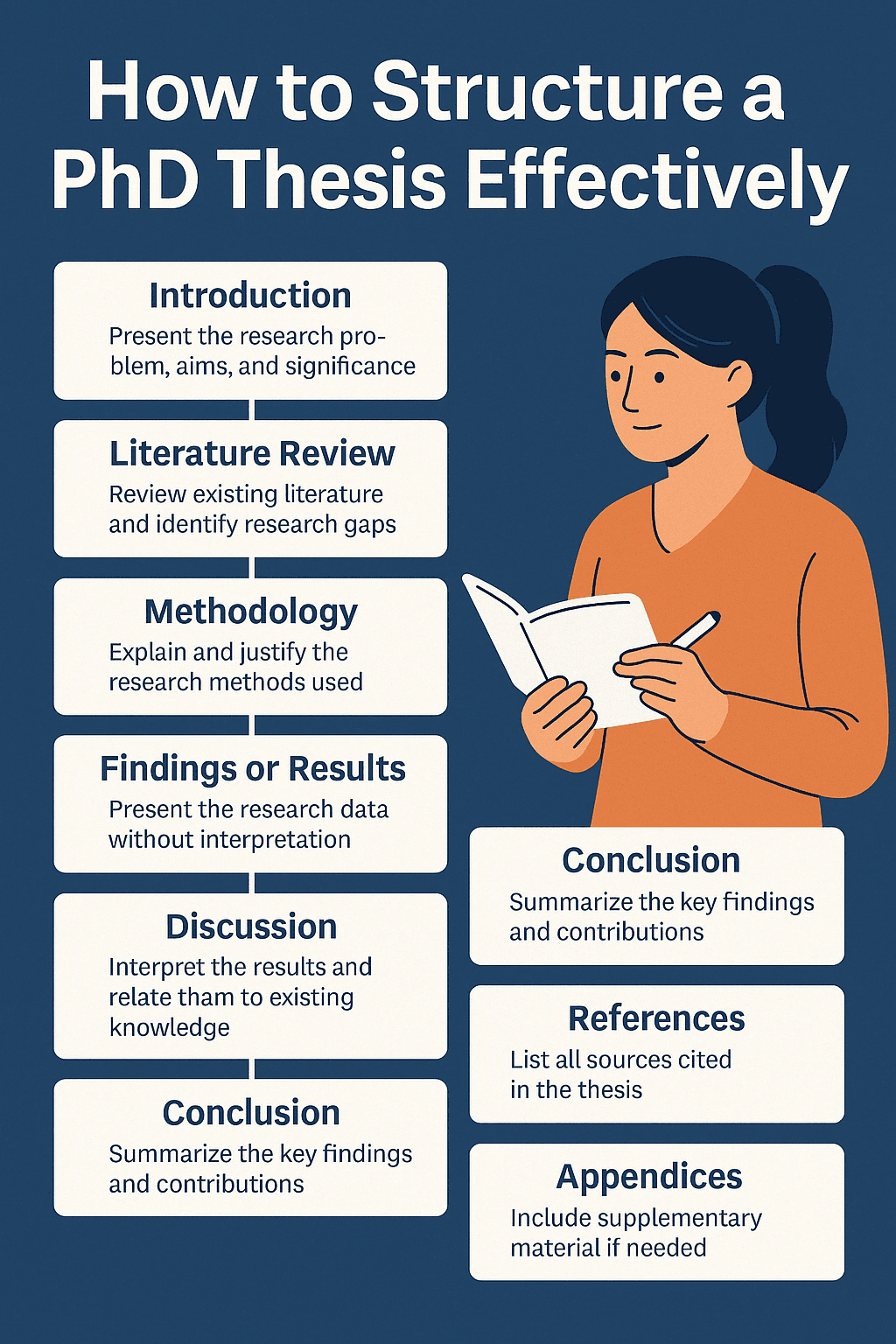
Writing a PhD thesis is one of the most intellectually demanding tasks in academic life. It represents the culmination of years of research and the foundation of your contribution to scholarly knowledge. But the challenge is not only in conducting rigorous research—it’s also in knowing how to structure a PhD thesis effectively.
An effective thesis structure enhances clarity, demonstrates coherence, and enables examiners and readers to easily follow your arguments. This guide will walk you through the standard structure of a doctoral thesis and offer examples and practical tips to support your writing process.
Compact Case Studies: The Bite-Sized Learning Revolution
Why Structure Matters in a PhD Thesis
A clear structure:
- Shows the logical flow of your research
- Enhances readability for supervisors and examiners
- Makes your arguments more persuasive and evidence-based
- Ensures all components of academic rigour are properly addressed
Learning how to structure a PhD thesis effectively will significantly improve your chances of passing your viva with confidence and potentially publishing your work thereafter.
Typical Structure of a PhD Thesis
Although structures can vary across disciplines and institutions, most PhD theses include the following key chapters:
1. Introduction
Purpose:
- To present the research problem, aims, and significance
- To introduce the research context and rationale
What to Include:
- Background of the study
- Clear statement of the research problem
- Research questions or hypotheses
- Research objectives
- Justification of the study
- Brief outline of methodology
- Structure of the thesis
Tip: Write this section early to set your direction, but revisit and refine it after completing the other chapters.
2. Literature Review
Purpose:
- To critically review existing literature and identify gaps your research addresses
What to Include:
- Theoretical frameworks or models
- Key themes and debates in the field
- Identification of research gaps
- Justification of your conceptual focus
Tip: Organise this chapter thematically rather than chronologically. Use subheadings to map key trends or perspectives.
3. Methodology
Purpose:
- To explain how the research was conducted and justify your methodological choices
What to Include:
- Research design (qualitative, quantitative, or mixed-methods)
- Sampling strategies
- Data collection methods
- Data analysis techniques
- Ethical considerations
- Research limitations
Example: A qualitative study may describe semi-structured interviews, participant selection, coding techniques, and thematic analysis using software like NVivo.
4. Findings or Results
Purpose:
- To present the raw results of your research in a clear and structured manner
What to Include:
- Data in the form of charts, tables, quotes, or summaries
- Key patterns or themes
- Supporting evidence without interpretation (save that for the discussion)
Tip: Organise the findings according to your research questions or themes identified in your analysis.
5. Discussion
Purpose:
- To interpret your results and relate them to existing literature
What to Include:
- How findings answer your research questions
- Comparison with past studies
- Implications for theory and practice
- Unexpected results or contradictions
Tip: Structure this chapter around your key findings and reflect critically on their meaning and impact.
6. Conclusion
Purpose:
- To summarise your thesis, reflect on contributions, and suggest future directions
What to Include:
- Summary of findings
- Theoretical, methodological, or practical contributions
- Limitations of your study
- Recommendations for future research
Tip: Avoid introducing new information in this chapter. Be concise and impactful.
7. References
Ensure your reference list follows your institution’s preferred citation style (e.g., APA, MLA, Harvard, Chicago). Use tools like EndNote, Zotero, or Mendeley to organise your citations.
8. Appendices (Optional)
Use appendices for:
- Interview transcripts
- Survey questionnaires
- Detailed data tables
- Ethics approval forms
Only include materials directly relevant to the content of your thesis.
Additional Tips for Structuring a PhD Thesis
- Start each chapter with a clear introduction and end with a summary
- Use headings and subheadings for better navigation
- Maintain a consistent academic writing style throughout
- Always align chapter content with your research questions
- Seek feedback regularly from your supervisor
Conclusion
Understanding how to structure a PhD thesis effectively is a vital skill that supports the clarity, coherence, and scholarly merit of your research. A well-structured thesis not only improves readability and comprehension but also strengthens your arguments and analytical depth.
By following a structured approach, adhering to academic conventions, and continuously refining your writing, you will produce a thesis that reflects the significance and quality of your research journey.
Visit The Case HQ for 95+ courses
Read More:
Successful Case Studies in Healthcare: What Can We Learn?
The Evolution of Case Studies in the Digital Era
Tips to Effectively Analyze a Business Case Study
How to Use Case Studies to Enhance Your Classroom Teaching Experience
Case Studies vs. White Papers: What’s the Difference and When to Use Each?
How Published Research Transforms Technological Advancements
Case Studies in Education: A Comprehensive Overview
The Emergence of Case Studies in Behavioral Sciences
Influencing Change: Case Studies in Nonprofit Organizations
Case Studies: Paving the Way for Inclusive Education
https://thecasehq.com/effective-guide-how-to-structure-a-phd-thesis-effectively/?fsp_sid=1172
Comments
Post a Comment